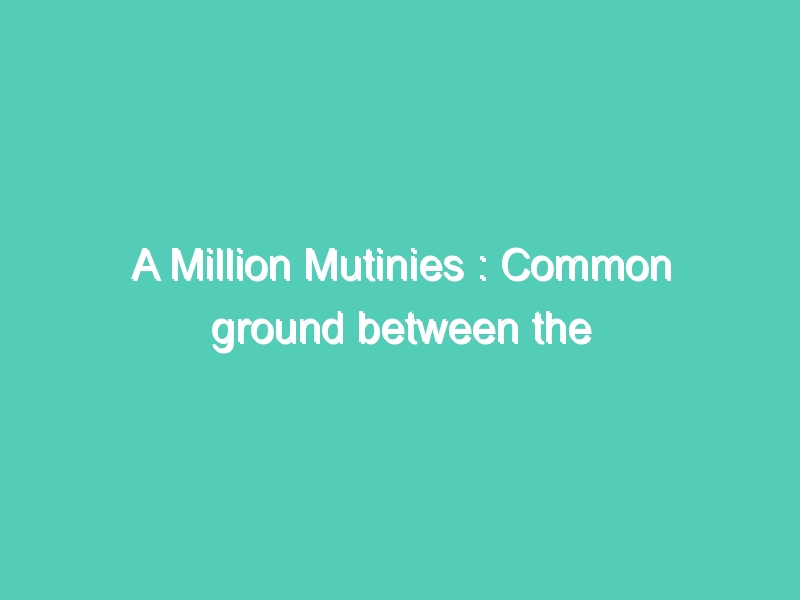On 25 June, a two-member suicide squad of the Islamist militant group Lashkar-e-Taiba ambushed a convoy of the Central Reserve Police Force on the Srinagar-Jammu highway, near the town of Pampore in the Kashmir valley. The attack left eight jawans dead, and over 20 injured. “I salute the courage of the CRPF personnel martyred today in J&K. They served the nation with utmost dedication. Pained by their demise,” Prime Minister Narendra Modi tweeted in response. There followed a chorus of mourning for them, on social and mainstream media.
One of the eight killed was Vir Singh, a Dalit from the village of Nagla Kewal, in Uttar Pradesh. When Singh’s body was brought home, the village’s dominant-caste residents refused to allow public land to be used for his cremation. After several hours of persuasion by district officials, they reluctantly surrendered a tiny plot for it.
In that moment in Nagla Kewal, the Kashmir and Dalit struggles overlapped. Singh was killed for upholding the dominant vision of India in the prevailing nationalist imagination. The discrimination he faced even in death exposed how strongly casteism continues to influence that imagination. This did not escape Dalit observers and activists. The “upper castes are anti-national,” one posted on Facebook. Another wrote, “Caste is bigger than the nation for them.” Some Kashmiris noted the connection too. One posted on Facebook, “The clever Brahmin will never get its feet wet. It’s the cannon fodder which it calls ‘untouchable’ or ‘lower caste’ that has to be slain in the ruggedness or to spill blood of the mountain people.”
Such instances of explicit overlap between the Kashmir and Dalit struggles are relatively rare. In the normal course of things, the events of each struggle are understood as being wholly distinct—including by many of those engaged in them—and are reported as such. Once the Nagla Kewal incident died down, this state of affairs reasserted itself, as evident in the mainstream reporting and commentary on the mass protests in Kashmir following the killing of the separatist militant leader Burhan Wani by security forces, and on those in Gujarat against the assault of seven Dalits for skinning a dead cow in the town of Una.
But in the reactions of Kashmiris, Dalits and their supporters as these events played out, there were signs of a budding awareness of common ground—even as those sharing these reactions were often located thousands of kilometres apart. In the past year, I have reported extensively for this magazine from the Kashmir valley, and from the University of Hyderabad. It is primarily by following the reactions of my acquaintances from the work in these locations that I noticed this trend. The two sides share an understanding of the character of the Indian state, and particularly of its character under the majoritarian rule of the Bharatiya Janata Party: as an oppressive force imposing Hindu nationalist territorial chauvinism in the Kashmiri case, and Brahminical caste chauvinism in the Dalit one.
I had already seen the shoots of such an awareness during my reporting. Earlier this year, I spent several weeks at the University of Hyderabad in the aftermath of the suicide of the Dalit scholar Rohith Vemula, which followed his suspension from the university after a confrontation with a member of the Akhil Bharatiya Vidyarthi Parishad, a Hindu nationalist student union. As I delved into the politics of the Ambedkar Students’ Association, of which Vemula was a part, its members told me of their attempts to create a “universal language of discrimination” and “a counter political space” in opposition to the ABVP’s politics of Hindutva and hyper-nationalism—which would take in numerous marginalised communities, including Muslims. Dalits on the campus and beyond were clear on who they held responsible for Vemula’s death: the university’s vice-chancellor, Appa Rao Podile; and also the Indian state, acting via a chain of politicians connected to the BJP, such as Smriti Irani and Bandaru Dattatreya, whom they accused of creating pressure for harsh action against Vemula and other members of the ASA. The criticism of the state only grew sharper as the controversy over Vemula’s death fed into the scandal that overwhelmed Jawaharlal Nehru University in Delhi in February, as several student leaders were accused of sedition and arrested. Ramji Chintagada, a Dalit student at the university and the president of the ASA, wrote on Facebook: “India decided what it wanted to be when being ruled by the British. Now let Kashmir decide what it wants to be. Their opinion would definitely show us if the present India is anywhere different to the British. And I believe the notion of unity or oneness is all the time propagated by the privileged to keep those underprivileged as they are.” Another student, the daughter of an army man, posted: “I love the army, but I’m critical about how it functions in Kashmir. To have to live in a state with constant surveillance and seeing guns at every corner is suffocating. 3 weeks of struggle for Rohith Vemula at campus was enough of seeing the lathis and tear gas vans. Imagine being born into it, being a terror suspect for existing, being checked, being enslaved to a nation that does all this and more in the name of your security.”
Many Kashmiris, of course, share this perception of the government, and especially of the current BJP-led government, as an antagonist. Towards the end of last year, I noticed simmering discontent against Jammu and Kashmir’s ruling government, an alliance of the Peoples Democratic Party and the BJP, when working on a profile of Mufti Mohammed Sayeed, the state’s chief minister until he died in January. Burhan Wani was still alive then, and immensely popular; I saw young Kashmiris flaunt his poster at their regular Friday protests against Indian security forces in Srinagar. When I met his father, Muzaffar Ahmad Wani, he told me, “Government runs the militancy here. You might ask me, how? Oppression. Death is preferable to the life of oppression. Militancy will be here as long as the Kashmir problem is not solved.”
There are also increasing parallels in the ways that the Hindu right, and hard-line Indian nationalists more generally, vilify members of both groups. Wani’s killing brought thousands of Kashmiris onto the streets in protest. Many right-wing voices on social media did not hesitate to call all of them terrorist-sympathisers—a label that has long been indiscriminately used against Kashmiris. Before Vemula’s suicide, the ASA, alongside other student groups, had voiced opposition to the execution of Yakub Memon, a chartered accountant convicted of involvement in the bombings in Mumbai in 1993, as part of a principled position against capital punishment. In the controversy that followed Vemula’s death, that same label was widely used against members of the ASA too, as well as any who stood beside them. Another term that has been applied to this group and to many Kashmiris is “anti-nationals”—which could be read as inadvertent acknowledgement of how opposition to a particular idea of Indian nationalism unites Dalit and Kashmiri activists.
Connections to Kashmir were prominent in posts online in the wake of the Una incident, when the headlines were dominated by the Kashmir protests and state forces’ brutal reaction to them. After the incident in Una, which was first publicised by a viral video of cow-protection vigilantes thrashing the seven Dalits in full public view, many Kashmiris were quick to react on social media, drawing links between it and their own experiences. Others also alluded to Kashmir while commenting on the incident. A retired professor based in Hyderabad wrote on Facebook: “A day will come when such victims will grab those sticks and hit back. Then they will be called militants and the CRPF and the BSF will arrive with rifles and pellet guns to protect the assaulters. And then they all together can jointly assault more victims happily ever after. India’s contemporary fairy tale of power.”
To a degree, such reactions in recent weeks must be attributed to the coincidence of these events with the latest unrest in Kashmir. But to dismiss them as stemming from nothing more than this is an oversight. The Dalit and Kashmir movements are, of course, very different in nature, and Dalit and Kashmiri experiences of violence also differ in many ways; yet both struggles are founded on a belief in human dignity and are fuelled by a sense of injustice and humiliation. And it is not only now that links between the two struggles are being articulated. For instance, Kashmiris were quick to sympathise with Vemula in the wake of his suicide. “The institution of the University in India is toxic,” one posted on Facebook. “It is responsible for the suicide, depression, deracination in Dalit students (and in the non-elite Muslim, Sikh, Kashmiri, Manipuri, Naga students). … Rohit Vemula’s suicide, and his letter (which reminds me of another letter from a Kashmiri murdered by the Indian State), is a revolutionary act (no less than that of Bhagat Singh).” With recent events—the repression in Kashmir, and the glaring failure to protect the Dalits assaulted in Gujarat—only emphasising the sense of injustice among both groups, and reminding them of the state’s role in it, there is room for the nascent empathy and solidarity to grow.
What is happening on social media is already starting to take more concrete organisational forms. Apart from the sense of solidarity between Kashmiris and Dalits, there is a wider empathy between Dalits and Muslims that is also founded on similar grounds. In the recent protests in Gujarat, Muslims came out to show support for Dalits, and at least one organisation, the Ahmedabad Muslim Youth Group, wrote to the government to demand a ban on cow-protection groups and criminal action against policemen who failed to protect those beaten in Una. In mid July, student groups at the University of Hyderabad, including the ASA, defied opposition from the campus administration to hold a meeting condemning the killing of protestors by state forces in Kashmir. Dontha Prasanth, an ASA leader, told me on the phone afterwards that he had spoken at the meeting, where he cited BR Ambedkar’s support for a plebiscite in Kashmir to decide on its inclusion in India. “When Ambedkar suggests plebiscite, he is giving people the prime importance,” Dontha said. “But what is happening now is that a certain rule is being imposed on people.” The majority of Indians won’t support self-determination for Kashmir, he continued, “because their nationalism and patriotism is only limited to the idea of geographical boundaries, but it has not cared about the peoples’ aspect. That’s why when atrocities against Dalits happen, it is only the Dalits who voice their opinion against it. There is not much reaction from caste Hindus. … It is only the right-wing imagination that exists in the opinions of the majority of people. That’s why there is aversion to discuss the issues of caste or Kashmir.”
Source: https://www.caravanmagazine.in/perspectives/million-mutinies-common-ground-kashmir-dalit



